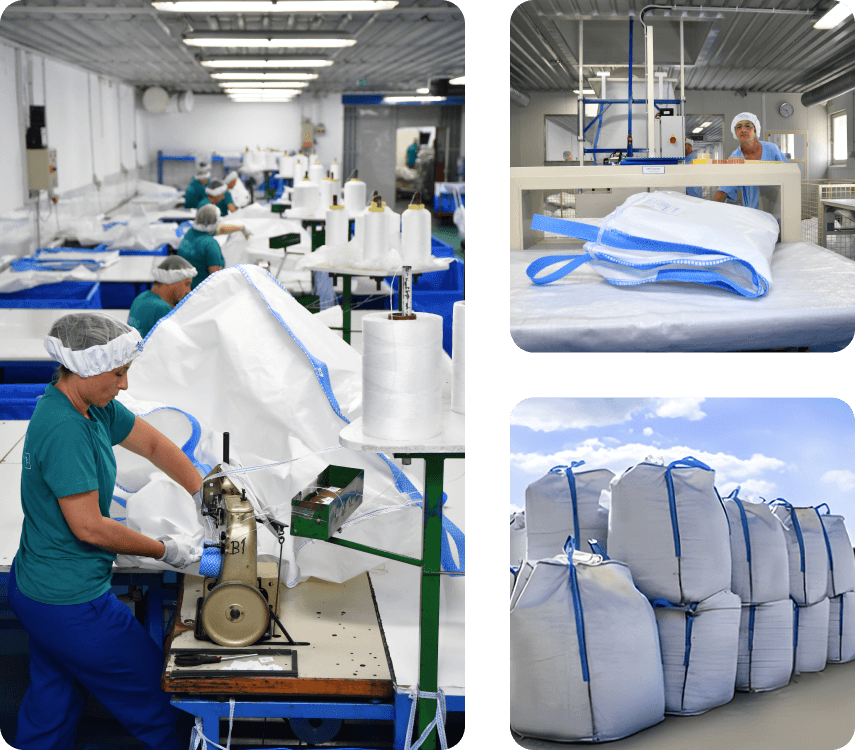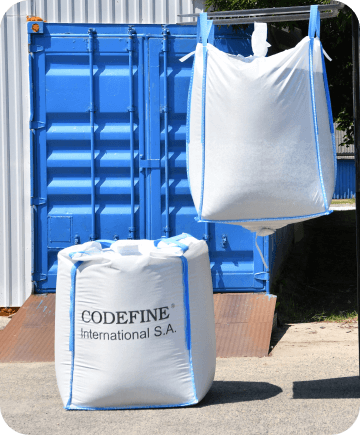Home » Posts Page » Blog » What Is SWL in FIBC Bulk Bags? A Complete Guide to Safe Working Load

What is SWL? In short, safe working load provides you with the maximum capacity FIBC containers can safely carry. SWL is typically displayed in pounds, and this limit needs to be adhered to to avoid breakage and accidents. Many different considerations go into the design and manufacturing of FIBCs to arrive at SWL.
Safe Working Load brings a level of assurance when working with FIBC bulk bags. Because they’ve been fully engineered to withstand specific loads, workers can handle them with more confidence, without the worry of injury or worse. As well as improving workplace safety, understanding SWL prevents bags from tearing or bursting, thereby preventing spillage, avoiding waste, and protecting profits.
By adhering to safe working load, you also protect machinery. Bulk bags that have been overloaded beyond their SWL can put a strain on hoists and other types of lifting equipment. In some cases, this can lead to complete failure of equipment. This is not only expensive to remedy but leads to costly downtime as your operation stalls.
In order to calculate the safe working load of FIBCs, extensive testing has to be carried out. To guarantee the SWL of an FIBC, these tests have to follow exacting industry standards. The key aspect of FIBC bag calculation for SWL is something called the Top Lift Test. This test not only determines the overall strength of a bag and its composition but also assesses the integrity of things like lifting straps. Once this testing is complete, a safe working load rating can finally be given to an FIBC.
To work out the exact safe working load of an FIBC container, you’ll need to have a couple of metrics to hand to complete your calculation. First, you’ll need to know the overall volume of your bulk bag. This is typically displayed in cubic feet. Additionally, you’ll need to know the density per square foot of the material you’re looking to store and/or transport in an FIBC. These two numbers are then multiplied together to provide you with the safe working load of an FIBC.
Calculating the SWL for FIBC bags might seem straightforward enough, but there are a lot of factors to bear in mind before you can accurately work out the safe working load of a bulk bag. Below are some of the most common mistakes people make when calculating SWL.
It might seem like common sense, but it’s important not to overestimate the capacity of an FIBC when calculating safe working load. All FIBCs will come with capacity limits provided, and it’s crucial that you stick to these when working out SWL before filling them.
Safety Factor (SF) is something else you’ll need to consider when calculating safe working load. FIBCs will bear one of two safety factors displayed in ratio form: 5:1 and 6:1. In order to obtain a 5:1 safety factor, a bulk bag needs to be able to accommodate five times its safe working load before bursting.
5:1 FIBCs are best reserved for more lightweight applications that can only be used once. By contrast, 6:1 FIBCs need to be able to withstand pressures six times that of their SWL during testing. Unlike 5:1 bags, they can be reused multiple times. However, they need to be fully inspected for signs of wear and tear before being reused.
Otherwise known as a live load, dynamic loads mean that the forces placed on an FIBC can vary considerably. While static loads make calculating SWL simple, dynamic loads can complicate matters. When calculating dynamic loads, the load rating of bulk bags needs to be followed precisely to avoid damage to materials and injury to workers.

Another common mistake people make when calculating SWL is the failure to consider the difference in FIBC bags types. SWL can vary, depending on how an FIBC is constructed. For example, the SWL of a 4-panel bag can differ from a baffle-top design. Meanwhile, a tubular FIBC can have a different SWL than a U-panel bag.
Even if a bag has previously passed safe working load testing with flying colors, there’s always the chance that bags have been damaged in between uses. Regular inspection of FIBCs can identify issues like tears, alongside more superficial damage. In some cases, bulk bags can be repaired before undergoing SWL testing and being deployed once again. Other times, FIBCs will need to be replaced entirely.
There are many ways you can maintain safe working load when handling FIBC containers. For starters, clear guidelines need to be in place regarding lifting operations, particularly in the case of complex activities. Planning and investment in training are vital, including guidelines on manual handling as well as lifting operations. Risk assessments also need to be carried out to ensure optimal safety standards are being met.
It’s also important to monitor the performance and stability of lifting equipment, including hoists, cranes, and forklifts. In order to plan for failure, thorough assessments need to be carried out to greenlight equipment for use. Even if SWL is being adhered to and key safety guidelines are being followed, it’s also important that equipment is strategically placed so it minimizes the amount of time lifts and attached FIBCs are suspended above people.
While all types of FIBCs provide a cost-effective and convenient packaging solution, safe working load needs to be considered before selecting a suitable bulk container. Fortunately, safe working load is fairly easy to calculate, provided you’re clear on a bag’s capacity and the density of the materials you’re looking to handle. Understanding the safety factor of a bag will give you an even clearer idea of SWL, as well as let you know if a bag can be reused multiple times before being discarded or recycled.
Looking for reliable FIBCs that meet all SWL standards? Codefine bulk packaging is the way to go. Leaders in sustainability and innovation, Codefine has been working with happy clients across multiple industries since the 1950s. Codefine packaging innovation means you can look forward to cutting-edge enhancements designed to streamline your operation, while our extensive product range means there’s a packaging option for every sector. Keen to discover more about Codefine packaging solutions? Explore the full range online or get in touch to discuss your requirements in more detail.